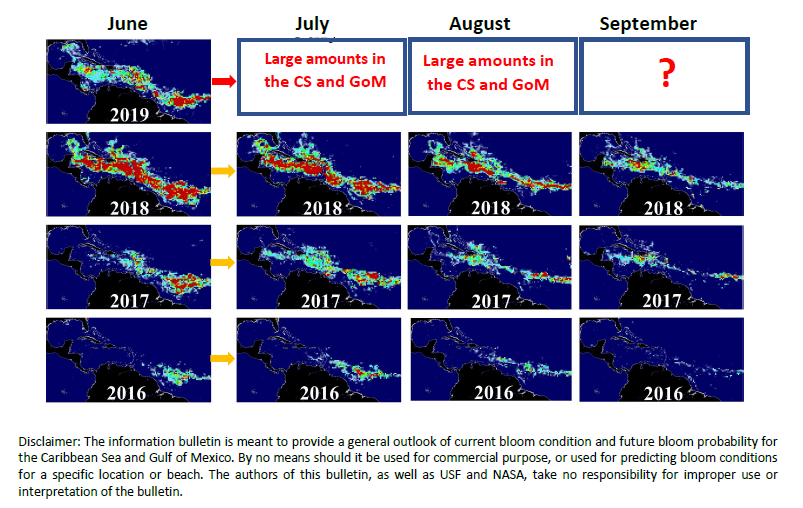The maps above show Sargassum abundance, with warm colors representing high abundance. In June 2019, the following regions continued to experience large amounts of Sargassum: Central West Atlantic
(CWA), entire Caribbean Sea (CS), eastern Gulf of Mexico (GoM), northern Florida Straits, and waters off east coast of Florida. In addition to numerous reports of Sargassum beaching in the Caribbean, beaching events have also been reported along the southeast coast of Florida. In the CS, the amount is lower than historical record in 2018 for the same month, but higher than the second highest record year of 2015 for the same month. In all regions combined, the total amount is estimated to be > 10 million metric tons, slightly higher than in June 2015 but lower than in June 2018 (> 20 million tons).
Looking ahead, because the amount of Sargassum in the CWA in June 2019 is higher than most previous years (except 2018), the transport of this amount to the CS is expected to be higher than most previous years, and possibly resemble the conditions in 2015. In general, the amount in the CS in July – August 2019 will continue to be high. Meanwhile, the transport to the GoM and east coast of Florida will continue, meaning that beaching events in the Florida Keys and along the east coast of Florida will also continue. The exact Sargassum amount, timing, and location of the beaching will depend on local ocean circulations and winds.
For summer 2019, because of the high amounts of Sargassum in the CWA, CS, and GoM in June 2019, large amounts of Sargassum (comparable to the 2nd largest amount in summer 2015) in the CS and Gulf of Mexico are a high possibility. More updates will be provided by the end of July 2019.
More information and near real-‐time imagery can be found under the Sargassum Watch System (SaWS, https://optics.marine.usf.edu/projects/saws.html ).
Outlook of 2019 Sargassum blooms in the Caribbean Sea and Gulf of Mexico by USF Optical Oceanography Lab



